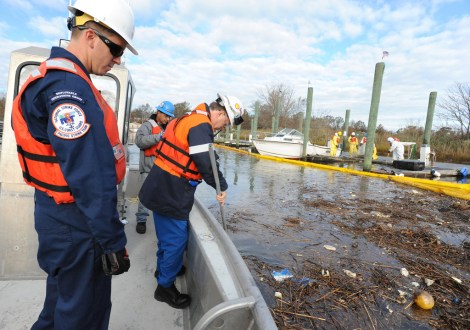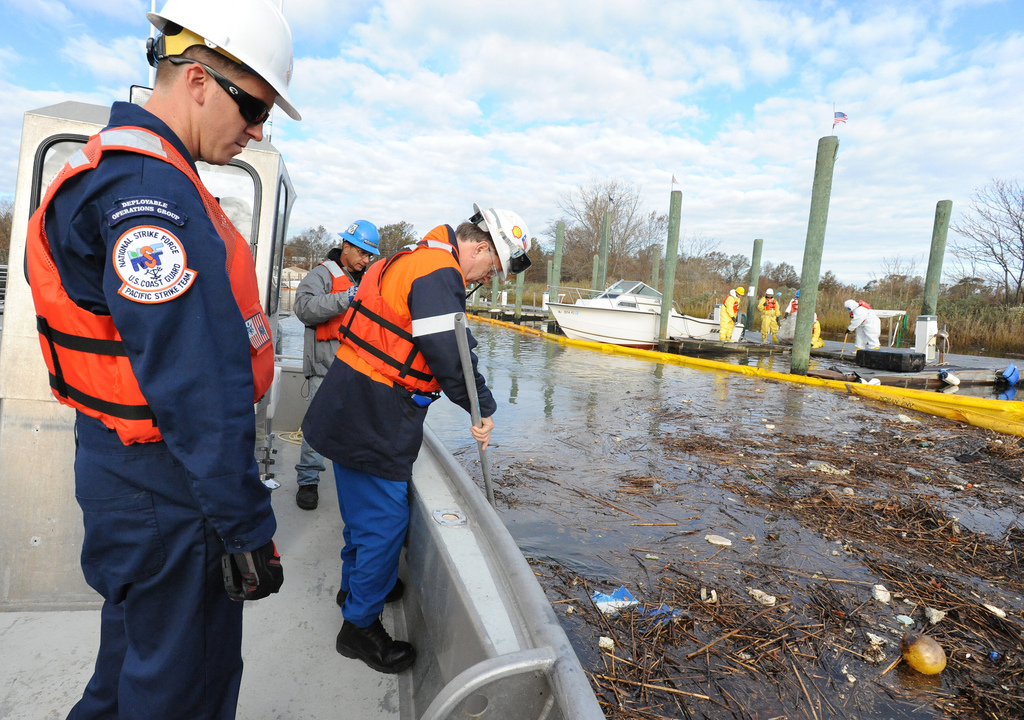Superfund sites and fuel spills and lead contamination, oh god!

U.S. Coast GuardThe Coast Guard sets about cleaning up an oil spill in New Jersey’s Arthur Kill waterway.
We’re learning more about the eco-impact of Hurricane Sandy, and it’s not looking good.
Nearly a quarter of New Jersey and New York’s Superfund toxic sites are within a half-mile of vulnerable coastal areas. Those the Environmental Protection Agency says were “impacted by the storm” include New York’s Gowanus Canal and Newtown Creek, both designated Superfund-supergross in 2010. From The Wall Street Journal:
The EPA said it tested water samples its workers took from Brooklyn’s Gowanus Canal and nearby flooded buildings, but found only “low levels” of potentially cancer-causing pollutants, which it said may be “related to spilled fuel and runoff from asphalt.” New York state officials say they think the floodwaters probably traveled over the Gowanus and Brooklyn’s other Superfund site, Newtown Creek, without disturbing the pollutants that line the bottoms of both waterways.
But Thomas Burke, a professor and associate dean at Johns Hopkins School of Public Health, said the Gowanus and Newtown Creek—whose cleanups haven’t begun in earnest yet—are more vulnerable to flooding risks than sites in more advanced stages of remediation, where caps and liners have already been placed over bottom-lying toxic material.
“There really has to be a careful evaluation of whether there has been any disturbing of the waste,” Mr. Burke, a former director of sciences and research at the New Jersey Department of Environmental Protection, said. “Flooding moves things around much more quickly.”
Fuel spills at refineries are also of concern, such as a 378,000-gallon diesel dump into New Jersey’s Arthur Kill waterway and a spill of heavy waste oil at a Linden, N.J., refinery. Also: heavy-metal pollution at the Raritan Bay Slag Superfund Site in Sayreville, N.J., where a 10,000-gallon fuel tank was overturned.
Delaware is bracing for Sandy-related debris and pollution to start washing up on the state’s beaches. From the Cape Gazette:
Dr. Andreas Muenchow, associate professor of coastal oceanography at the University of Delaware, said debris that ends up on Delaware’s shores generally comes from the north, but most of the trash and pollution from New York and New Jersey as a result of Sandy will stay out to sea.
Muenchow said large debris would be trapped off of Cape May because of tidal currents. Debris within the Delaware Bay from Philadelphia is more likely to arrive on Delaware’s shoreline, he said.
Behind the MERR building, volunteers collected a wheelbarrow full of debris that has already washed up in the days since the storm.
“Debris that has washed into the water from land is a hazard, and highly contaminated water is also a huge concern,” Thurman said.
Debris floating in the water could injure marine animals, while contaminated waters could cause sickness and death, she said.
The Coast Guard says 137 people are currently working on pollution cleanup. I think this might take a while.



